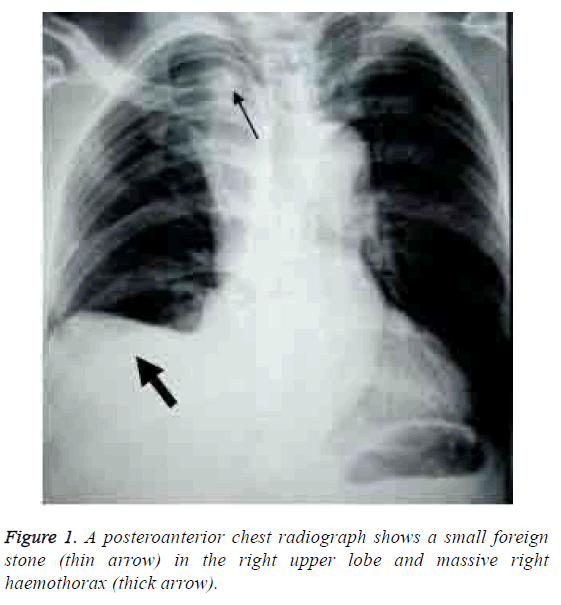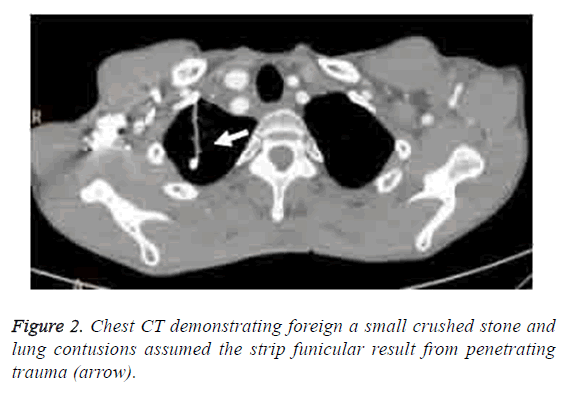ISSN: 0970-938X (Print) | 0976-1683 (Electronic)
Biomedical Research
An International Journal of Medical Sciences
Research Article - Biomedical Research (2017) Volume 28, Issue 22
Penetrating chest trauma with massive hemothorax by a small stone
Department of Cardiothoracic Surgery, the Lu’an Affiliated Hospital, Anhui Medical University, No. 21 of Wanxi West Road, Lu’an City, China
- *Corresponding Author:
- He-Ping Huang
Department of Cardiothoracic Surgery
The Lu’an Affiliated Hospital
Anhui Medical University, China
Accepted date: October 14, 2017
A patient who presented with penetrating chest trauma and massive hemothorax by a small stone required tube insertion as part of his therapy. In contrast, hemodynamically unstable patients require emergency department thoracotomy to stop the bleeding and evacuate the pleural space. This is treated with an intercoastal chest drain. The management of the traumatic hemothorax by closed thoracic drainage is an effective treatment for traumatic hemothorax induced by a small foreign body, since tube drainage can avoid the incidence of thoracotomy related complications.
Keywords
Penetrating chest trauma, Haemothorax, Closed thoracic drainage, Emergency treatment, Foreign body.
Introduction
Chest penetrating trauma represents a common challenge in treatment. Furthermore, hemothorax is the most common clinical manifestation of chest trauma resulting from both penetrating and blunt factors. The optimal treatment of chest penetrating trauma with hemothorax remains a challenge, and it is difficult to make a reasonable selection according to the cause of chest injuries and its clinical presentations. Therefore, it is extremely significant to pursue an effective treatment for chest penetrating trauma. The incidence that a small foreign object penetrates the pulmonary lobe parenchyma is rare. In general, the mortality from pulmonary penetrating injuries is higher due to vascular injury, massive hemothorax and shock [1].
Case Report
A 61 y old conscious male was penetrated by a small stone in the chest and transported to the emergency department of our hospital. The chest of the patient was accidentally penetrated by a small stone that came from a high-speed rotating blender at the right supraclavicular location. The patient exhibited chest pain, tightness in the chest and difficulty in breathing. Chest radiograph [2] and CT confirmed a small foreign body (approximately 5 mm in length, Figures 1 and 2) in the right upper lobe parenchyma with a right massive hemothorax (Figure 1), and pulmonary contusions [3] were presented by the funicular strip (Figure 2).
After the shift from the Emergency Department to cardiothoracic surgery, closed thoracic drainage was immediately administrated. More than 1,600 ml of hemothorax was drained from the chest tube for a period of 15 h. Laboratory tests revealed that the concentration of hemoglobin was 7.0 g/dl, the number of white blood cells was 12.5 × 109/L, and neutrocyte percentage was 87%, respectively. Electrocardiography, oxygen saturation and blood pressure were monitored. Supplemental oxygen, hemostatic, Red Blood Cell (RBC) infusion and antibiotics were also conducted. Hemothorax was not evacuated after six days of drainage through the chest drainage tube.
CT scans demonstrated the absence of residual hemothorax in the pleural space. After removal of the tube, the patient was followed up after one month; and there was no occurrence of complications.
Discussion
Lung parenchyma is one of the most easily injured tissues caused by penetration and blunt trauma [4]. Chest penetrating trauma is frequently initiated by gunshot, shrapnel, stab wounds, and iatrogenic accidents. However, it is a distinctly rare entity that the chest penetrating trauma was caused by the penetration of a small stone. Much attention has been given to treatment strategies [5,6] for chest penetrating trauma with hemothorax penetrated by foreign bodies in previous reports, which a terrible clinical result that had no relation with the size of the object [7].
Conclusion
This report presents a rare case that the chest of the patient was accidentally penetrated by a small stone from a high-speed rotating blender at the right supraclavicular location. Moreover, it is found that the management of traumatic hemothorax [8] by closed thoracic drainage is an effective treatment of traumatic hemothorax induced by the penetration of small foreign bodies.
Competing Interests
The authors declare that they have no competing interests. No financial or other relationships have to be declared.
References
- Bawany FI, Khan MS, Khan A, Dar M. Successful surgery of massive thoracic injury in a girl following chest trauma. J Pak Med Assoc 2013; 63: 1571-1573.
- Heydari F, Esmailian M, Dehghanniri M. Diagnostic accuracy of ultrasonography in the initial evaluation of patients with penetrating chest trauma. Emerg (Tehran) 2014; 2: 81-84.
- Alisha C, Gajanan G, Jyothi H. Risk factors affecting the prognosis in patients with pulmonary contusion following chest trauma. J Clinic Diagn Res 2015; 9: 17-19.
- Chou YP, Kuo LC, Soo KM, Tarng YW, Chiang HI, Huang FD. The role of repairing lung lacerations during video-assisted thoracoscopic surgery evacuations for retained haemothorax caused by blunt chest trauma. Eur J Cardiothorac Surg 2014; 46: 107-111.
- Ilhan M, Gok AF, Oner G, Gunay K, Ertekin C. A penetrating dorsal thoracic injury that is lucky from every aspect: A case report. Int J Surg Case Rep 2016; 23: 82-84.
- Singh KP, Joshi AK, Joshi MK, Joshi C, Singh M, Singh V. Wooden stick penetration from the perineal region up to the thorax. World J Emerg Med 2015; 6: 305-307.
- OConnor JV, Adamski J. The diagnosis and treatment of non-cardiac thoracic trauma. JR Army Med Corps 2010; 156: 5-14.
- Karavis MY, Argyra E, Segredos V, Yiallouroy A, Giokas G, Theodosopoulos T. Acupuncture-induced haemothorax: a rare iatrogenic complication of acupuncture. Acupunct Med 2015; 33: 237-241.

